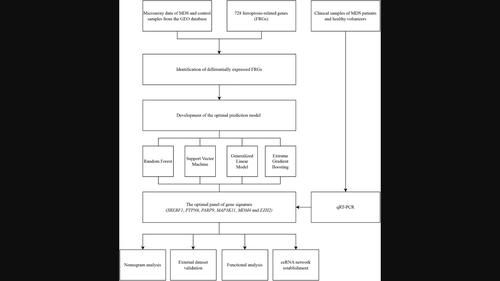当前位置:
X-MOL 学术
›
Immun. Inflamm. Dis.
›
论文详情
Our official English website, www.x-mol.net, welcomes your feedback! (Note: you will need to create a separate account there.)
Construction and experimental validation of a novel ferroptosis‐related gene signature for myelodysplastic syndromes
Immunity, Inflammation and Disease ( IF 2.493 ) Pub Date : 2024-04-05 , DOI: 10.1002/iid3.1221 Yidong Zhu 1 , Jun He 2 , Rong Wei 2 , Jun Liu 1
Immunity, Inflammation and Disease ( IF 2.493 ) Pub Date : 2024-04-05 , DOI: 10.1002/iid3.1221 Yidong Zhu 1 , Jun He 2 , Rong Wei 2 , Jun Liu 1
Affiliation

|
BackgroundMyelodysplastic syndromes (MDS) are clonal hematopoietic disorders characterized by morphological abnormalities and peripheral blood cytopenias, carrying a risk of progression to acute myeloid leukemia. Although ferroptosis is a promising target for MDS treatment, the specific roles of ferroptosis‐related genes (FRGs) in MDS diagnosis have not been elucidated.MethodsMDS‐related microarray data were obtained from the Gene Expression Omnibus database. A comprehensive analysis of FRG expression levels in patients with MDS and controls was conducted, followed by the use of multiple machine learning methods to establish prediction models. The predictive ability of the optimal model was evaluated using nomogram analysis and an external data set. Functional analysis was applied to explore the underlying mechanisms. The mRNA levels of the model genes were verified in MDS clinical samples by quantitative real‐time polymerase chain reaction (qRT‐PCR).ResultsThe extreme gradient boosting model demonstrated the best performance, leading to the identification of a panel of six signature genes: SREBF1 , PTPN6 , PARP9 , MAP3K11 , MDM4 , and EZH2 . Receiver operating characteristic curves indicated that the model exhibited high accuracy in predicting MDS diagnosis, with area under the curve values of 0.989 and 0.962 for the training and validation cohorts, respectively. Functional analysis revealed significant associations between these genes and the infiltrating immune cells. The expression levels of these genes were successfully verified in MDS clinical samples.ConclusionOur study is the first to identify a novel model using FRGs to predict the risk of developing MDS. FRGs may be implicated in MDS pathogenesis through immune‐related pathways. These findings highlight the intricate correlation between ferroptosis and MDS, offering insights that may aid in identifying potential therapeutic targets for this debilitating disorder.
中文翻译:

骨髓增生异常综合征的新型铁死亡相关基因特征的构建和实验验证
背景骨髓增生异常综合征(MDS)是一种克隆性造血疾病,其特征是形态异常和外周血细胞减少,有进展为急性髓系白血病的风险。尽管铁死亡是MDS治疗的一个有前景的靶点,但铁死亡相关基因(FRG)在MDS诊断中的具体作用尚未阐明。方法MDS相关微阵列数据从Gene Expression Omnibus数据库中获得。对MDS患者和对照者的FRG表达水平进行全面分析,然后利用多种机器学习方法建立预测模型。使用列线图分析和外部数据集评估最佳模型的预测能力。应用功能分析来探索潜在的机制。通过定量实时聚合酶链式反应 (qRT-PCR) 在 MDS 临床样本中验证了模型基因的 mRNA 水平。结果极端梯度增强模型表现出最佳性能,从而鉴定了一组六个特征基因:SRBF1 ,PTPN6 ,PARP9 ,MAP3K11 ,MDM4 , 和EZH2 。受试者操作特征曲线表明,该模型在预测 MDS 诊断方面表现出较高的准确性,训练组和验证组的曲线下面积值分别为 0.989 和 0.962。功能分析揭示了这些基因与浸润免疫细胞之间的显着关联。这些基因的表达水平在 MDS 临床样本中得到了成功验证。结论我们的研究是第一个使用 FRG 来预测患 MDS 风险的新模型。 FRGs 可能通过免疫相关途径参与 MDS 发病机制。这些发现强调了铁死亡和MDS之间复杂的相关性,提供了可能有助于确定这种使人衰弱的疾病的潜在治疗靶点的见解。
更新日期:2024-04-05
中文翻译:

骨髓增生异常综合征的新型铁死亡相关基因特征的构建和实验验证
背景骨髓增生异常综合征(MDS)是一种克隆性造血疾病,其特征是形态异常和外周血细胞减少,有进展为急性髓系白血病的风险。尽管铁死亡是MDS治疗的一个有前景的靶点,但铁死亡相关基因(FRG)在MDS诊断中的具体作用尚未阐明。方法MDS相关微阵列数据从Gene Expression Omnibus数据库中获得。对MDS患者和对照者的FRG表达水平进行全面分析,然后利用多种机器学习方法建立预测模型。使用列线图分析和外部数据集评估最佳模型的预测能力。应用功能分析来探索潜在的机制。通过定量实时聚合酶链式反应 (qRT-PCR) 在 MDS 临床样本中验证了模型基因的 mRNA 水平。结果极端梯度增强模型表现出最佳性能,从而鉴定了一组六个特征基因:



























 京公网安备 11010802027423号
京公网安备 11010802027423号